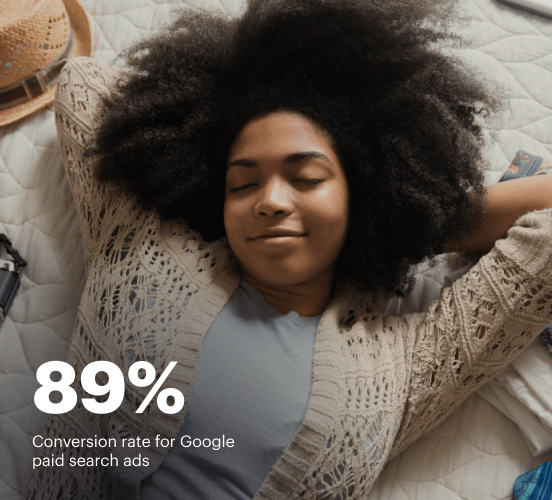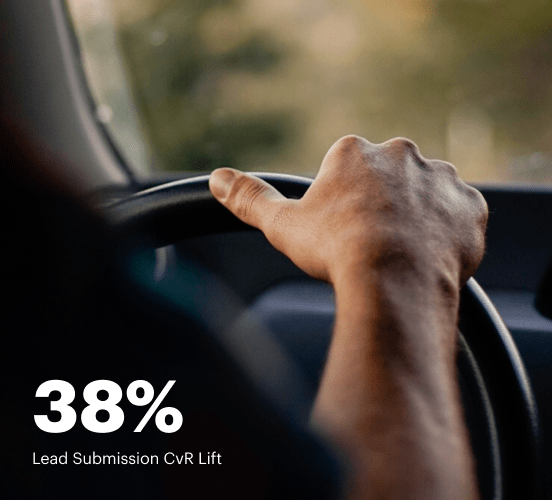Webflow vs. Drip: the best platform for a seamless web experience
Discover how Webflow compares to Drip regarding features and usability. Find out which platform provides the competitive advantage your business deserves.
Get startedSee how Instapage stacks up against the competition
| Feature | Instapage | Other builders |
| Drag-and-Drop Tools | ||
| Conversion-optimized templates | ||
| Manual and AI-powered A/B Tests | ||
| AI content suggestions | ||
| Popups and sticky bars | ||
| Canvas and grid blocks | ||
| Reusable and global elements | ||
| Form and popup builders | ||
| Built-in Heatmaps | ||
| Central analytics dashboard | ||
| Ad-to-page personalization and collections | ||
| Contacts, lists, and email | ||
| Dedicated, full-service CRO experts | ||
| Enterprise-ready platform |
Leading the way in building high-performing landing pages





Why Instapage is the smarter choice for your campaigns
Get everything you need to build, scale, and optimize high-converting landing pages—without coding.

Easier page building without coding
Instapage offers a flexible and seamless page creation experience with a library of 500+ conversion-focused layouts, Instablocks®, a drag-and-drop builder, and AI content generation. With technologies like Thor Render Engine®, you can create on-brand, mobile-responsive landing pages that load quickly and start converting during initial visitor clicks.

More insights — better results
Instapage lets you see in detail how each landing page experience and variation is performing so you can make targeted changes that boost page conversions. Use heatmaps for a better understanding of on-page activities, run A/B tests and AI-assisted experiments, and then track and evaluate results within robust analytics dashboards.

More personalized experiences
Instapage lets you quickly create high-performing landing pages tailored to each of your ad campaigns. Deliver personalized experiences for distinct audiences using dynamic text replacement. Effortlessly align specific advertisements to unique pages with AdMaps. Monitor audience-level metrics using our advanced data tools.

Built-in collaboration
Instapage collaboration capabilities bring your entire team together to speed up the process of landing page review, approval, and launch. No more frustrating and unnecessary revisions or edits scattered across emails. Provide instant feedback, conduct real-time page edits, and securely share your pages with outside stakeholders.

Free up time for your business
Invest time into business growth, not busy work. Launch landing pages faster with reusable forms and templates. Build once, reuse forever.
Explore all integrations






Easier page building without coding
Instapage offers a flexible and seamless page creation experience with a library of 500+ conversion-focused layouts, Instablocks®, a drag-and-drop builder, and AI content generation. With technologies like Thor Render Engine®, you can create on-brand, mobile-responsive landing pages that load quickly and start converting during initial visitor clicks.
More insights — better results
Instapage lets you see in detail how each landing page experience and variation is performing so you can make targeted changes that boost page conversions. Use heatmaps for a better understanding of on-page activities, run A/B tests and AI-assisted experiments, and then track and evaluate results within robust analytics dashboards.
More personalized experiences
Instapage lets you quickly create high-performing landing pages tailored to each of your ad campaigns. Deliver personalized experiences for distinct audiences using dynamic text replacement. Effortlessly align specific advertisements to unique pages with AdMaps. Monitor audience-level metrics using our advanced data tools.
Built-in collaboration
Instapage collaboration capabilities bring your entire team together to speed up the process of landing page review, approval, and launch. No more frustrating and unnecessary revisions or edits scattered across emails. Provide instant feedback, conduct real-time page edits, and securely share your pages with outside stakeholders.
Free up time for your business
Invest time into business growth, not busy work. Launch landing pages faster with reusable forms and templates. Build once, reuse forever.
Explore all integrationsGet started with Instapage in a few steps
-
Create your Instapage account
Start with Instapage by signing up via Google or your email. You'll get access to a free 14-day trial to discover Instapage capabilities. Feel free to cancel anytime during the 14-day trial if you decide that our product is not suitable for your business. -
Build and personalize your page
Create your first landing page from scratch or choose a template from 500+ customizable layouts. Use the drag-and-drop builder to add page elements, fonts, and backgrounds, refine content with AI, or add custom HTML, Javascript, and CSS. -
Review and make edits
Collaborate on page designs and streamline review processes. Invite your team members and stakeholders to review, edit, and provide feedback on your landing page. Collaborate knowing your page is confidential and only accessible to authorized users. -
Publish and track page performance
Publish your page to a domain or custom URL. Connect your pages to the ads you've created and track page performance within the analytics dashboard, run A/B tests and AI experiments, analyze results, and continuously optimize your landing page to maintain high conversions.
Webflow vs. Drip: A Comprehensive Comparison
As the digital landscape evolves, the need for effective landing page builders becomes paramount. Choosing the right platform can feel like navigating a vast ocean, particularly considering the number of options out there. Two players that dominate this arena are Webflow and Drip. Each one boasts impressive features, user-friendly interfaces, and potential to boost your marketing strategy. However, their approach is distinct, and that’s where things get interesting. Webflow emerges as a powerhouse for designers looking to create visually stunning websites without extensive coding knowledge. With its robust design capabilities, users can get creative and produce bespoke designs tailored to their brand. On the flip side, Drip is a formidable player in the email marketing space, focusing on automation and customer relationship management. Its targeted campaigns and comprehensive tracking underscore its mission to turn leads into loyal customers. But there's a third contender lurking in the wings: Instapage, noted for its simplicity and efficiency in creating high-converting landing pages. In this comparison, we'll dive deep into the ins and outs of these platforms to help you decide which might be your ideal choice.
Introducing the Contenders: Webflow, Drip, and Instapage
In one corner, we have Webflow. Known for empowering designers, it facilitates the creation of responsive sites without needing to touch code. Its flexibility allows brands to establish a unique online presence seamlessly. In the other corner, Drip presents itself as the ultimate tool for eCommerce marketers, providing advanced automation that attracts and retains customers. With an emphasis on data-driven marketing, Drip offers a plethora of tools for analyzing consumer behavior, giving businesses the upper hand in crafting personalized marketing strategies. Yet, Instapage steals the show when it comes to landing pages. It focuses primarily on conversion optimization, offering a myriad of templates and A/B testing that make it easy to create effective landing pages tailored to specific audience segments. Each of these platforms carries distinct strengths, giving users an array of choices depending on their goals. Whether you desire design flexibility, email automation, or conversion-focused landing pages, there’s something for everyone in this triad.
Feature Comparison: What Each Platform Brings to the Table
When it comes to platform features, both Webflow and Drip showcase tools designed to streamline marketing efforts. Webflow shines with its design-centric capabilities, providing users with the freedom to manipulate every aspect of web layout and style. Meanwhile, Drip prides itself on its automation features, enabling marketers to set up workflows that engage customers at optimal times. However, Instapage isn't to be overlooked; it offers superb tools for page personalization and conversion tracking that both Webflow and Drip could benefit from integrating into their offerings. Let’s take a closer look at the key features of each platform, highlighting how they cater to marketers' needs in today’s competitive landscape.
User Experience: Navigating the Learning Curve
Navigating the features of a new platform can sometimes feel like a workout, especially for those who are just getting started. Webflow excels in providing an intuitive design experience, with a user interface that encourages creativity and exploration. New users may find themselves initially overwhelmed by the tools available, but once they get the hang of it, the design freedom is rewarding. Drip, on the other hand, brings a user-friendly dashboard that’s geared toward marketers looking for clear analytics and straightforward automation options. While both platforms aim to cater to varying experience levels, the journey is smooth – albeit with distinct learning curves. The humor lies in exploring these platforms; learning to use them effectively is akin to picking up a new sport: it's all about practice, some smart strategies, and finding the right rhythm.
Features That Make Webflow Stand Out
- Highly customizable and responsive design options
- Intuitive interface that fosters creativity and design exploration
- Integrated CMS for dynamic content creation
- SEO-friendly tools built into the platform
- Easy deployment and hosting capabilities
Unique Features of Drip
- Advanced segmentation and targeting for personalized marketing
- Robust email automation workflows
- Deep analytics for tracking customer interactions
- Integration with numerous eCommerce platforms
Common Strengths: What Both Platforms Share
- Responsive design options for mobile and desktop
- Comprehensive analytics for measuring performance
- User-friendly interfaces aimed at non-techies
- Integration capabilities with third-party tools
- Focus on enhancing customer engagement
- Strong support resources available
As we observe these two contenders battling in the arena, it’s important to note that while they both have their strengths, Instapage may seamlessly integrate the best of both worlds. It brings usability and performance into the spotlight, making it a formidable choice, particularly for marketers focused on optimizing conversion rates.
Page Performance: Speed and Responsiveness
When evaluating any platform, performance is key, particularly regarding the loading speed of web pages. Nobody enjoys waiting for a page to load when they could be exploring content. In this fast-paced digital environment, even a delay of a few seconds can lead to diminished user satisfaction. Webflow prides itself on exceptional loading times thanks to optimized coding practices. However, Drip, with its automation-focused services, emphasizes quick access to data and campaign results. Both platforms offer solutions for mobile responsiveness, ensuring that users have a consistent experience across devices. Both Webflow's blazing speed and Drip's quick data retrieval cater effectively to the impatient digital consumer, establishing them as reliable players for marketers.
Support and Resources: Who's Got Your Back?
No matter how user-friendly a platform is, having robust support can make all the difference. Webflow offers an array of educational resources, from detailed documentation to an active community forum. Users can easily find guidance for any design conundrum they encounter. Conversely, Drip shines in customer support, providing targeted resources and a dedicated team to assist marketers press forward with their campaigns. Both platforms ensure users are well-equipped to tackle any challenge that arises. Each support team acts as a helpful sidekick, ready to assist with quick responses and valuable insights, aiding users in maximizing the potential of their chosen platform.
Dollars and Cents: A Look at Pricing Models
Exploring Webflow's Pricing Structure
- Flexible plans catering to various user needs
- Transparent pricing with no hidden fees
- Ability to scale as a business grows
- Competitive pricing relative to features offered
Understanding Drip's Pricing Approach
- Pay-as-you-go model accommodating businesses of any size
- Comprehensive features included across all plans
- Pricing based on list size, offering better clarity
- Opportunity for scaling as customer base grows
- Focus on long-term business relationships
In conclusion, pricing strategies vary between Webflow and Drip, with each platform offering distinct advantages that cater to different user bases. Nevertheless, Instapage presents an excellent balance of flexibility and value tailored for marketers seeking optimal return on investment.
With transparent pricing plans, there’s a refreshing honesty about costs, encouraging users to see the value they're getting. Sometimes, surprises lurk in unexpected places, making it essential to weigh your choices carefully.
What Can Instapage Offer That Stands Out?
Finally, let’s turn our attention to Instapage. This platform is like the wise mentor in the marketing journey, equipped with unique value propositions aligning perfectly with modern marketers' needs. Instapage doesn't just provide templates; it prioritizes conversions, offering comprehensive A/B testing tools and personalized landing page experiences that make a tangible difference in performance. Such features could make a significant impact when measuring success. While Webflow and Drip have their merit, they may not offer the same depth in landing page capabilities as Instapage does, making it the go-to choice for those focused on maximizing conversions. Instapage's customer-centric approach, combined with its full suite of tools, allows marketers to create and implement highly effective campaigns. With an easy-to-navigate interface, it positions itself as a tool that any marketer can wield effectively, streamlining the marketing process and enhancing campaign success rates.
As we wrap up this comparison, the key takeaway is the importance of choosing the right platform tailored to your unique goals. Each platform has its strengths, but with thoughtful consideration, you can select a tool that aligns perfectly with your business ambitions. Exploring further with Instapage may just be the ticket to elevating your marketing strategies and achieving desired outcomes.










